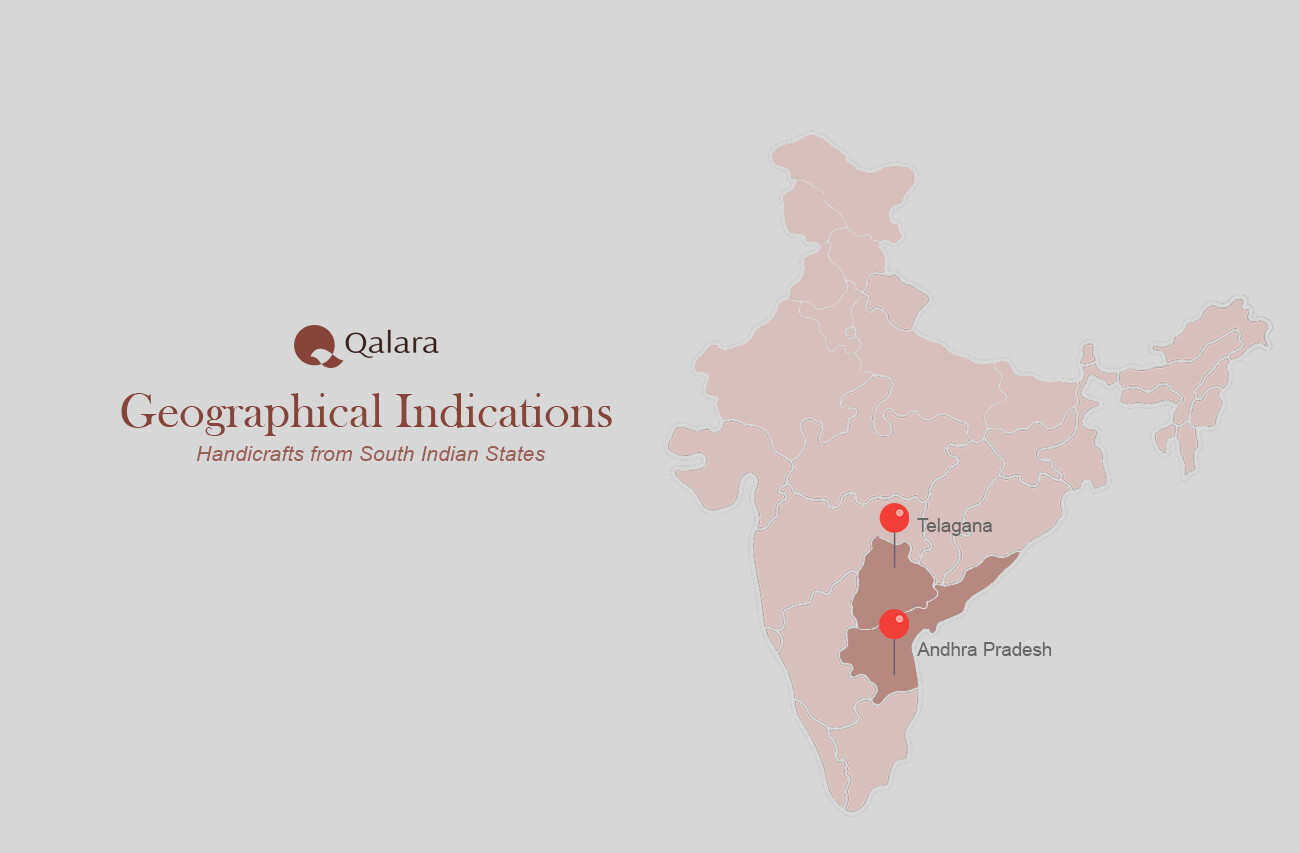
Crafting legacy: GI handicrafts from South India (I)
journey through the handicraft beauty of South India is steeped in deep-rooted cultural history and intricate artistry. Handwoven wonders, silk sarees, traditional Indian toys, temple crafts, and brassware are a few of the most celebrated offerings of South India. Cherishing the region’s uniqueness, this article seeks to highlight some of the GI-tagged handicrafts that value the native core and show you the authenticity of South India through exotic crafting.
Despite being geographically close to each other, it is astonishing, the kind of uniqueness and differentiation each of the 5 southern states shows in terms of their crafting ethos. A stark duality can be seen in the closeness to their folk roots while facilitating migrated tribes, international travelers, and ruling kingdoms alike, to lend their culture to their existing design style.
Having a coastal line made the South an international sea route where a fusion of cultures was certain. Blessed with a coastal tropical climate rich in resources, the region has a long history of producing crafts of remarkable quality.
Following our celebration of exquisite North Indian handicrafts, this series delves into the equally captivating world of GI-tagged crafts from South India’s Andhra Pradesh and Telangana! Get ready to be amazed by these fantastic stories from the South.
Table of contents:
Andhra Pradesh
• Popular GI handicrafts
1. Andhra Pradesh leather puppetry
GI issued on 9th September, 2008

Origins: Andhra Pradesh Leather puppetry is called ‘Tholu Bommalata’ in its native language of Telugu and translates to its English moniker (tholu- leather; bommalata- puppetry). The craft comes from the remote village of Nimmalakunta in Andhra Pradesh. The artisans practicing it were from the ‘Marathi Balija’ community who originally migrated from the western Indian region of Maharashtra in search of livelihood in the 3rd century.
Their shows majorly performed folklore and stories of mythological Indian epics like the Mahabharata and Ramayana. Their craft found patronage from the erstwhile kingdom ruling the Nimmalakunta area. Both common locals and royalty enjoyed this art as one of their prominent sources of entertainment in an era that did not have films or theater.
Traditional usage: The craft was initially limited to crafting puppets for shows which was the core purpose of the whole art. The puppets were put in between a bright screen and a light source, which gave the puppetry performance a beautiful color-shadow effect. The puppets boast a versatile aesthetic, offering a unique visual experience with and without light.
Contemporary influence: The advent of films and television challenged leather puppetry’s place in society. As the art form grappled for relevance, government heritage initiatives sparked a revival by introducing new applications for the craft.
Now, the community makes around 150 varieties of decorative creations, from paintings and lamp shades to wall hangings, and modern puppets used in decor. While staying true to its mythological, character-based designs, the community has adopted a Western design sensibility, to appeal to a global audience and to promote tourism.
Crafting process: Tanned leather is used as a canvas to draw design outlines with a pencil or charcoal. The outlines are etched with a chisel after which artisans dye it with beautiful, vibrant colors. The texture of the leather makes the puppets look lifelike and dynamic.
Traditionally the puppets were holed with strings passing through, for the puppeteers to perform with them. In contemporary applications, the crafting is adapted according to various product use cases.
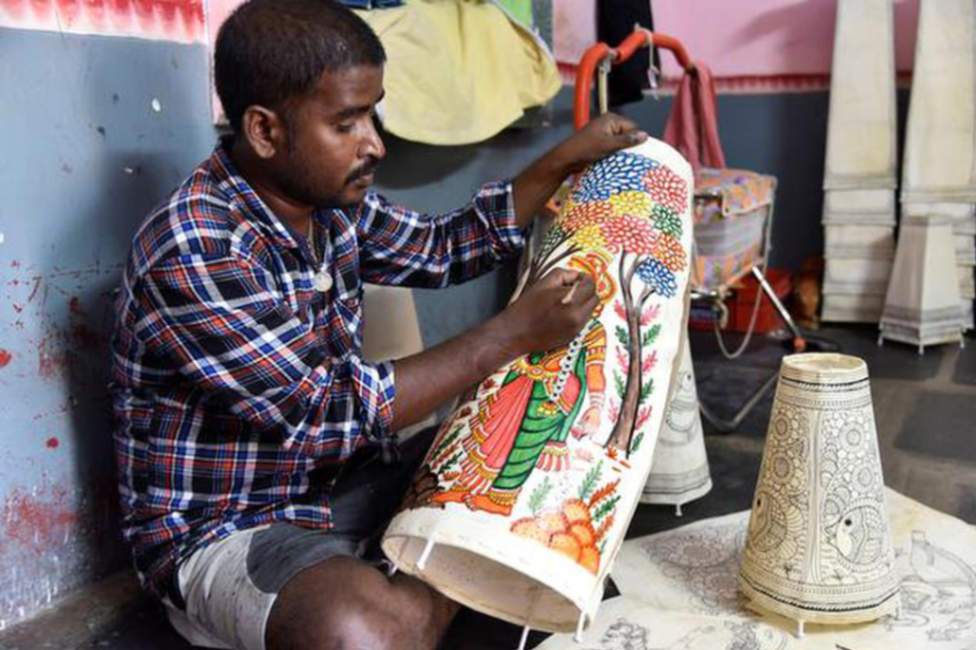
Raw materials: The puppets are crafted from readily available goat leather, a timeless choice. Natural dyes bring the figures to life in a vibrant palette.
2. Machilipatnam kalamkari
GI issued on 10th July, 2008

Origins: The Machlipatnam kalamkari craft comes from a variation of the original Sri Kalahasti kalamkari craft. Kalamkari originally translates to ‘pen-work’ and involves hand drawing designs on a fabric with colors. The Machlipatnam crafting school, however, carves its designs on wood, employs block printing, and uses natural dyes.
This craft received great patronage from the Mughal dynasty and the Golkonda sultanate. This created a beautiful fusion of Persian, Muslim, and Hindu design aesthetics.
Traditional usage: Kalamkari fabrics were canvasses in Hindu temples and started as a craft that tells stories of mythology at the place of worship. The designs include deities, storytelling, and lots of botanical design patterns.
Contemporary influence: Kalamkari was too beautiful to be restricted to temples. Presently, it has grown to be a fabric from which multiple products like traditional sarees, home furnishings, bed sheets, curtains, and many more are made. Today, the craft receives global recognition with the Victoria Albert Museum of London also displaying the fabric.
Crafting process: The wooden blocks used for printing are usually made from tough rosewood. Sandalwood is also used which is less durable. First, the designs are drawn on paper which artisans refer to to carve on the wooden block. Designs are dissected based on color and each color-based sub-pattern is carved on a different block.
The dyes usually consist of red, blue, green, yellow, and brown. Red, indigo, and yellow are the primary dyes mixed to produce secondary colors.
Each Kalamkari design takes 23 meticulous steps to fix onto the fabric. The fabric is washed free of starch first, dried, and then treated with a mordant as a fixative to ensure the natural dyes adhere properly. After each color print, the fabric is sun-dried and washed in still or running water. Another color cannot be printed until the fabric is completely dry. This process is repeated based on the number of colors in the designs. Artisans show great precision in printing different colors with extreme precision and simple manual skill. A kalamkari fabric takes around a month to make. A true labor of love!

Raw materials: The designs are printed on pure cotton fabric that is washed and treated first.
Natural dyes are extracted from tree bark, flowers, fruits, vegetables, and other natural materials. The extracted dyes are treated with fixatives and filtered in a muslin cloth, before use. These natural dyes have a beautiful earthy shade and differentiate Machilipatnam kalamkari from any other printing style.
3. Budithi bell & brass metal craft
GI issued on 9th September, 2008
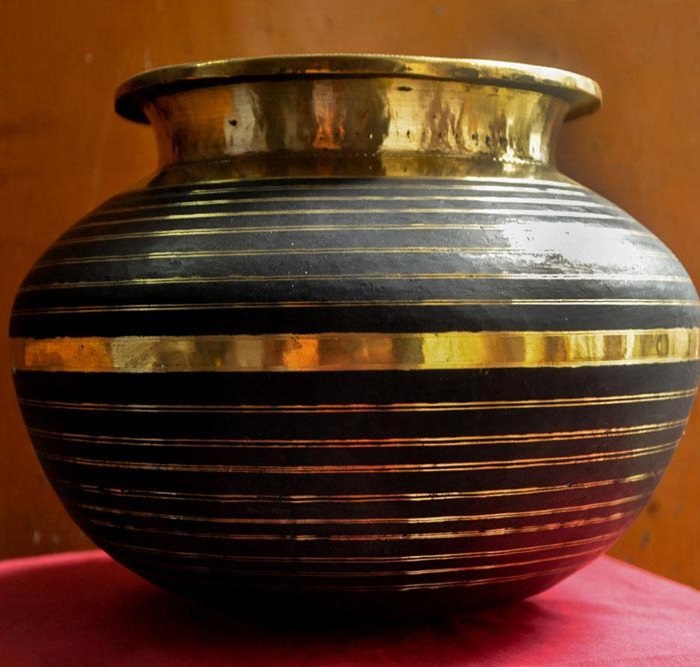
Origins: The village Budithi, from where this craft comes, is located around 40 kilometers from the northern coast of Andhra Pradesh. The community of artisans who practice this art originally used to be jewelry craftsmen with high skill in carving designs on metal.
While they received great royal patronage, jewelry crafting became common over time, forcing them to adapt. That is when they discovered the beauty of brass. As they understood the uniqueness of its visual aesthetic and the possibility of carving designs on it, a new era of crafting began for them.
Budithi bell and brass crafts are world-renowned now and the artisans who practice this craft are considered to be undisputed masters in brass crafting.
Traditional usage: The community’s crafts majorly involved making brass bells for temples. The resonant acoustic characteristics of brass make it a great choice for bells. The artisans carved their signature designs which comprise geometrical lines & curves, and floral patterns. Multiple shades of the metal only make it more beautiful over time.
Another major application is kitchen brassware. These include traditional vessel pots, jugs, drinkware, and cookware. Brass utensils are also known to have a lot of health benefits and add a distinct flavor to food, bringing more fame to the products. Take a look at Qalara’s range of brassware kitchen offerings here.
Contemporary influence: Over time, these native products naturally lost to the mass-manufactured, industrial revolution, making it a very niche craft. Now, the artisans’ community is reduced to around 20 units and 60 artisans.
However, government initiatives, GI tags, and efforts from the community helped with its resurgence. They have adapted to contemporary themes and requirements by venturing into products like lamps, decoratives, flower pots, vases, and planters.
Crafting process: Two shades of brass sheets are beaten together until they come to a desired shape. The sheets are then welded together and the inside is polished. In situations like making a vessel, jug, or vase, a ring is welded to the neck of the product to complete the structure.
The inside is polished and the outside is scraped to bring a beautiful luster to the offering. The outside is carved with beautiful designs. Complementing the sheens of brass is a black non-toxic powder that is locally sourced and used as a coating on the offering, making it a truly unique piece, personal to Budithi.

Raw materials: Brass metal is the one metal that makes up this crafting process. It is made from an alloy of zinc and copper. One other element is the non-toxic black powder used for coating.
• Lesser-known GI handicrafts
4. Kondapalli Bommalu
GI issued on 12th January 2006

Origins: The ‘bommalu’ in the name translated to ‘toys.’ The name completely translates to ‘Toys of the village Kondapalli.’ Kondapalli village is a very prominent cultural center located in the central region of Andhra Pradesh.
The craft originated in the 16th century and was introduced by the ‘Raju’ community of the village who also call themselves ‘Aryakshatrias.’ The community migrated to Kondapalli from Northern India claiming their crafting skill was a gift passed on generationally since it was taught to their ancestors by the Hindu god Shiva himself.
Traditional usage: These toys are traditionally a huge part of the Hindu harvest festival of Sankranti. One of the Sankranti festivals is the ‘Bommala Koluvu’ wherein wooden toys and figurines are arranged in an order, such that they tell stories of harvest, life, courtship, and Hindu mythology.
Kondapalli toys have been a significant attraction in processions depicting figurines inspired by rural life, Hindu epics, and deities.
Contemporary influence: Modern-day influences have drastically affected this craft. By 2020, the number of households practicing this craft within the community had dwindled to a mere two or three. This decline can be attributed to two factors: the marginalization of the craft by the British during their rule, and a lack of interest among the younger generation, who are drawn to cheaper Chinese imitations.
It didn’t help that the softwood traditionally used to make it became harder to find. Also, crafting these toys is extremely time-consuming. Certain organizations are however taking up initiatives to get this craft back in the game. Incentivized programs are also being conducted for craftswomen in the village to encourage more and more people to embrace the beauty of their art.
Crafting process: The process starts with the selection of the apt softwood which is very easy to carve in intricate designs. Once the design of the desired figurine is decided, craftsmen use chisels and knives for carving. Making everything from clothing, hair and even facial features needs an extreme level of precision.
Once the design is carved, comes coloring. Tamarind seeds and sawdust are mixed to form a paste called ‘makku.’ It is predominantly used as a coating layer that joins all the pieces. Natural colors made out of vegetables, fruits, flowers, and leaves are then painted on this layer. Once colored, the figurines are left to dry in the sun. After the figurines are completely dry, the artisans may highlight the toy with narrow strokes, to complete it.

Raw materials: The softwood used in crafting these toys is a special kind of wood known as ‘tella poniki’ in their native language. It is exclusively found in the Kondapalli forest areas making the craft even more irreplicable.
There is no substitute for this wood since it is soft enough for precision carving and gives a bright and beautiful color shade when painted.
Telangana
• Popular GI handicrafts
1. Pembarthi metal craft
GI issued on 6th October, 2010

Origins: The metal craftsmen of the Pembarti village have always been known for their outstanding skill in forging sheet metal. These craftsmen were known as the ‘vishwakarmas.’ While Pembarthi was ruled by the Kakatiya kingdom which built a lot of temples under its reign for which the Vishwakarmas were given the job of designing the places and installing idols. Their unmatched skill and beautiful aesthetics gained lots of praise all over the country.
Traditional usage: Temple crafts were traditionally produced through this technique. As different rulers and various cultural influences affected the community, other products were added to their list. A prominent influence was the Nizam rule which introduced products like betel nut boxes, perfume containers, metal chandeliers, plaques, and mementos.
Contemporary influence: The craft survived through a lot of ups and downs right from political turbulence to contemporary relevance. While it has been looking to find footing in the modern market, it has evolved from crafting simple novelty offerings and expanded into utilitarian products. Today, the Pembarthi method also results in products like kitchenware, slowly building up their relevance.
Crafting method: Working with sheet metal, the artisans first carve their design using a pointed stylus. Once the design is properly done, the acid etching technique is used to create deep indents on the sheet. These designs are shaped, polished, and often coated with lacquer or enamel to protect them from corrosion.

Raw materials: Bronze and brass are the two most extensively used metals in this craft. Their beautiful vintage raw browns add a unique aesthetic to the technique.
2. Nirmal toys and craft
GI issued on 22nd April, 2008

Origins: The softwood toys, furniture, and paintings collectively known as the ‘Nirmal crafts’ are crafted by a community of crafters called ‘Naqqash artisans’ who live in the town of Nirmal. This community migrated to Nirmal, Telangana in the 17th century from the Northern part of India and started using local materials and resources to create these products. Extensive patronage during the rule of the Nizam helped flourish the art even more, resulting in the present-day variety.
Traditional usage: Along with toys, the crafts of Nirmal were also known for their paintings, handicrafts, miniature figures, and a few utilitarian offerings. All these products have a high influence on natural elements and are also known to take inspiration from the fresco designs on the walls of Ajanta and Ellora caves.
Contemporary influence: The crafts today have a good demand in Indian and international markets. The toys are known to be great gifting choices as the novelty of souvenir articles. Buying a Nirmal toy for a loved one has become a standard for tourism visiting the southern part of India today.
Crafting method: The toys are crafted using a locally found softwood, apt for intricate carving. The wooden figurine is covered with Luppam and colored using vegetable dyes and herbal extract that give a unique shine and golden sheen to the toy. The colors used for the painting are also similar. Enamel paints are another option that is used.

Raw materials: The softwood used is a variety called ‘poniki’ or white sander which is very comfortable for crafting.
Also read: Qalara’s toys hit the famous Hamleys stores
3. Pochampally Ikat
GI issued on 31st December 2010

Origins: While the ikat tie & dye style of textiles has lots of hubs around India and the world, the variety practiced in the village of Pochampally has a unique beauty and stands out from the others.
Ikat entered the Indian crafting scene as a part of the silk route that brought the arts of India and the Mediterranean together. As time passed, multiple weavers around the county adopted this enticing art and localized it with their native touch. One such variation was the Pochampally ikat style.
Traditional usage: Pochampally’s main product is its ikat sarees. Handloomed patterns on these mean that the artisans take imaginative inspirations from the nature around them and imbibe these themes in the sarees which acted as large canvases to showcase their artistic ideas.
Despite natural themes, the standard design style is that of geometric pattern, a trait synonymous with the Ikat technique. The true mark of a Pochampally saree among these others is the border design which touts feather patterns.
Contemporary influence: In attempts to meet higher demands and modern consumer preferences, the artisans have even ventured into making modern dresses. The ikat designs are also a part of furniture work and home decor items today. Pochampally ikat has had a great run with booming demand, thanks to consistent efforts by the government and other patrons along with its irreplicable handmade charm.
Crafting method: In the ikat dyeing technique, the yarns are already dyed and set in weft and warp, according to the intended design. The weavers loom with intense care and precision. Slight imperfections and design variations are considered as a mark of beauty that keeps the humanly artistic aesthetic in the craft alive.

Raw materials: Cotton, silk, and sico fabrics are normally used in weaving Pochampally ikats. Fabric often ends up being a blend of two materials as well.
4. Silver filigree of Karimnagar
GI issued on 16th May, 2007

Origins: The silver filigree work is called ‘Vendi teega pani’ in the native Telugu language which translates to ‘silver wirework.’ This intricate silver work in the Karimnagar district came to the place around 200 years ago from a nearby village.
A goldsmith by the name of Karala Ramayya was the pioneer of this style who learned the filigree technique in jewel making and brought a new variation to the way it is used in crafting. Centuries later, the silver filigree work of Karimnagar became a flourishing craft that received a GI tag and represents its city in its work!
Traditional usage: Conventionally used to produce stunning jewelry accessories, silver wirework designs are beautiful and surprising in how they make for simple yet stunning accessories. The thin wirework that fills gaps are predominantly geometric patterns but the bigger ones are full-blown designs that take inspiration from flowers, birds, and musical instruments among others.
Contemporary influence: The silver filigree craftsmen have been disciplined with sticking to their craft which enabled them to live through years of uncertainty. Today it boasts as a center for handmade jewelry, has an amazing tourist demand, and has been patronized by the government and multiple organizations. Attempts to take it to more global markets and help upscale the quality of living of its craftsmen have also been a constant endeavor.
Crafting method: Filigree deals with silver wires of multiple thicknesses being forged according to the design. The thickest wires form the outline and solid designs. The thinner ones are often joined together to fill more precise spaces while the extremely thin wires are shaped into geometric patterns that are extremely intricate and fill the hollow design beautifully.

Raw materials: Silver rods or wires are at the core of this craft and are the only material that goes into the making of it.
• Lesser-known GI handicrafts
5. Siddipet Gollabhama
GI issued on 19th March 2012

Origins: The Gollabhama sarees of Siddipet are a very recent art form with their origin dating back to only 60 years ago in the 1960s when it reached its pinnacle. The design of these sarees was inspired by the Yadava community women who often carried pots of milk on their heads and distributed it in all houses. The weavers took artistic inspiration in this pose and fancied the design which eventually became a whole craft. ‘Gollabhama’ is a Telugu word that translates to ‘milkmaid.’
Traditional usage: The idea was to weave traditional sarees with the ‘Gollabhama’ motifs which continues to be the norm. It was an evident favorite when it started in the Siddipet town with over 2000 weavers working on these designs by the 1960s.
Contemporary influence: These laborious, hand-loomed textiles fell back with the advent of power looms, steady advancement, and industrialization. Multiple designers, conservationists, and native craftsmen are working towards its resurgence, even finding success with patronage from film celebrities and politicians. Attempts to bring modern technology into the craft while retaining the core are also in the works. A steady resurgence is a hope in the years to come.
Crafting method: The ‘Gollabhamma’ motifs come on the borders of the saree. They are neither embroidered, nor printed, but woven into the saree with extreme skill and precision. The intended design is first drawn on a graph and given to the weaver who uses 80-100 threads to weave it in.
The threads are passed through warps with yarns being pulled down and adjusted based on the design. Weavers keep swinging the pedal on the loom to pull the string down around 100 times! It is an extremely time-consuming task with a beautifully rewarding Gollabhamma design in the end!

Raw materials: The sarees are woven out of pure cotton.
Conclusion
From Andhra’s leather puppetry and Budhiti bell craft to Telangana’s Nirmal toys and Siddipet art, we hope you enjoyed this journey mapped across the two southern Indian states and their awe-striking handicrafts that are GI-approved. Keep supporting us as we bring you more of South’s craft techniques originating from the regions of Karnataka, Kerala, Puducherry, and Tamil Nadu. Which of these would you like us to cover next? Let us know in the comments below!
~ Written by Dhanush Dandu





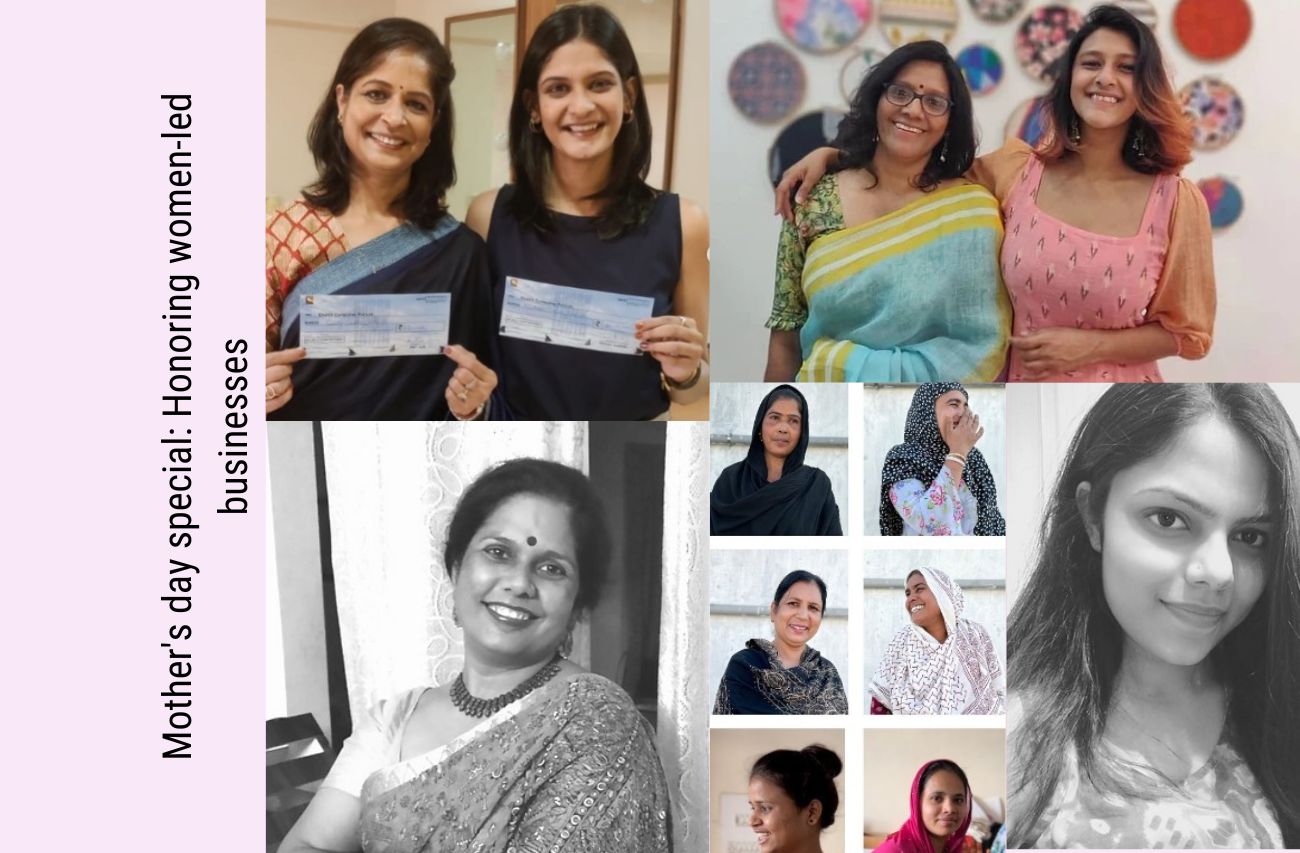
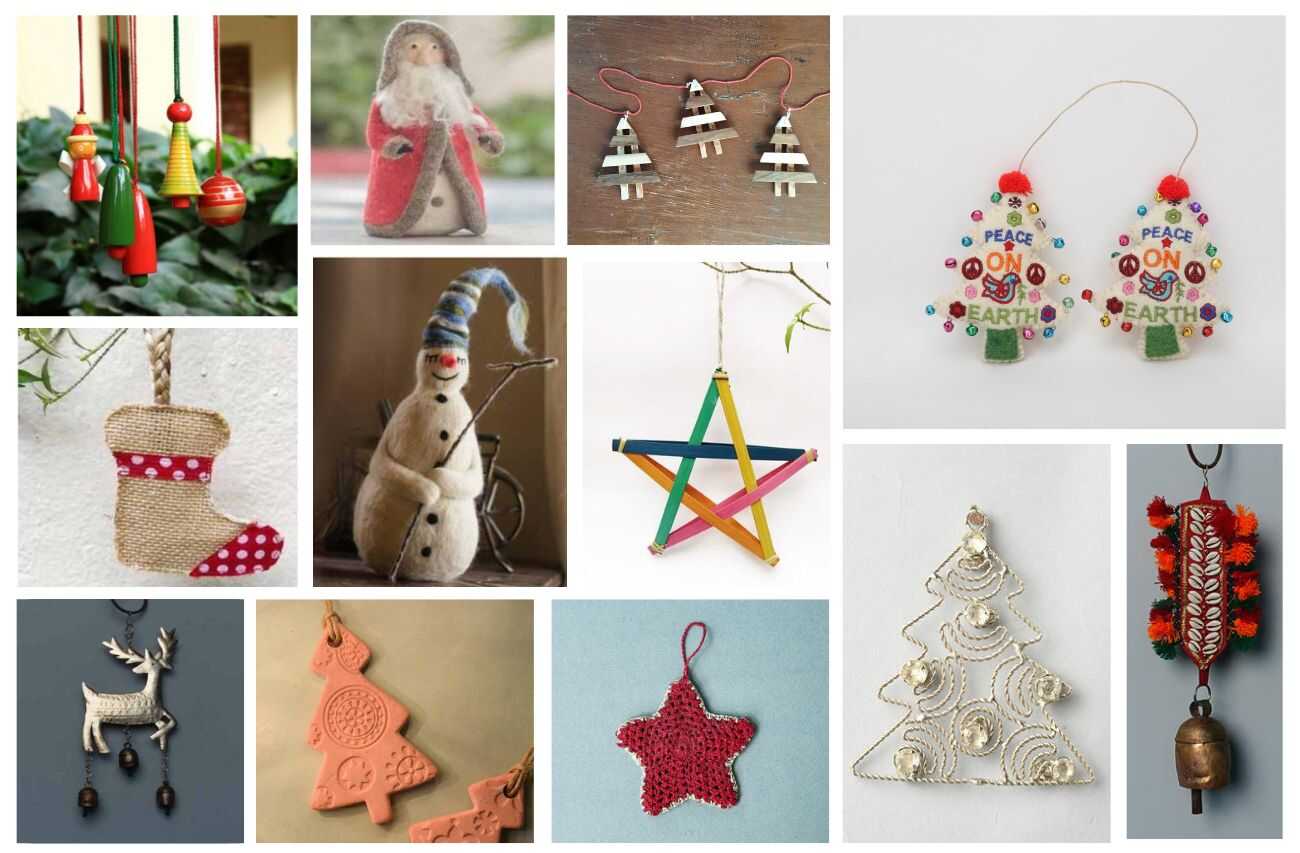
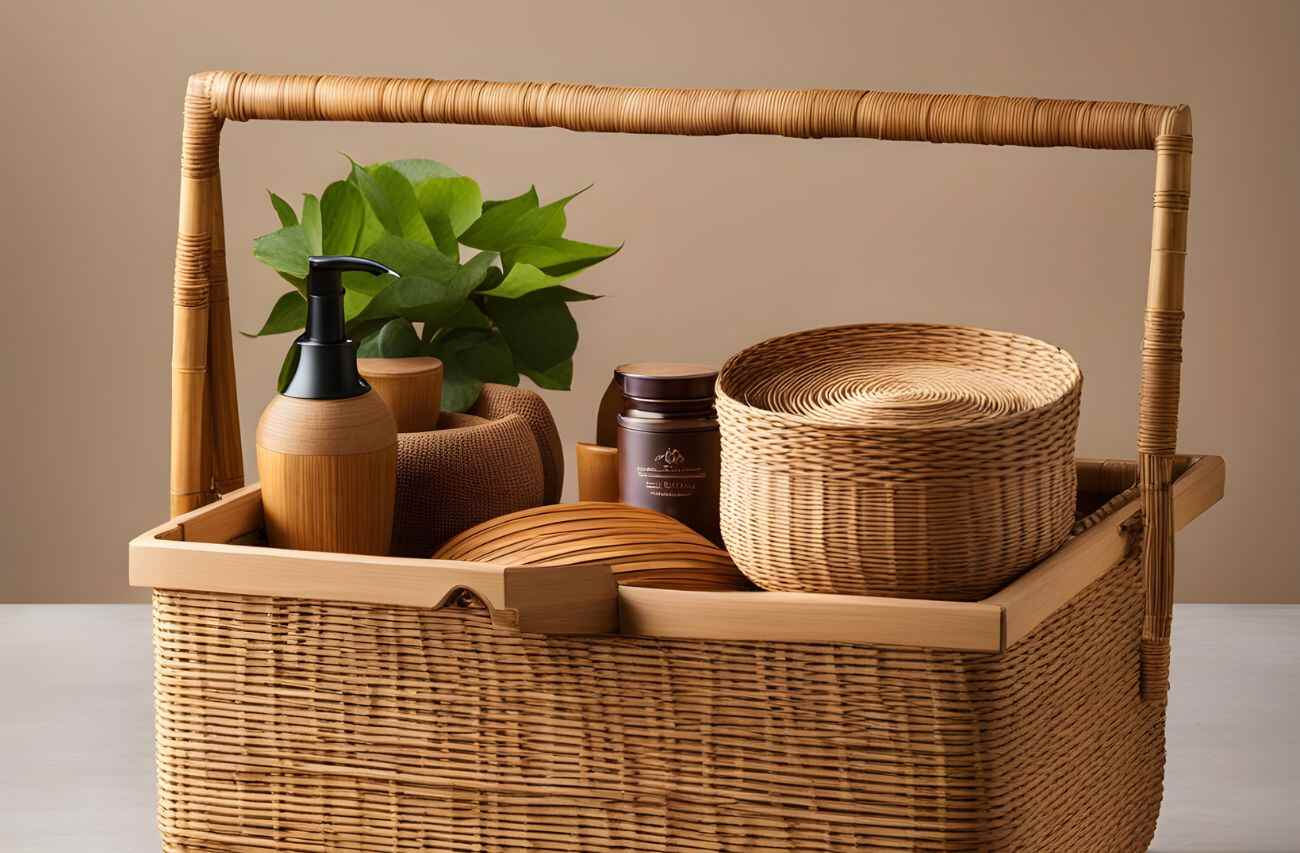
Ryan L
This is so awesome! I don’t suppose I’ve read through anything like this before. So nice to find somebody with a few original thoughts on this issue. Thanks for starting this up. This web site is something that is needed on the web, someone with some originality!